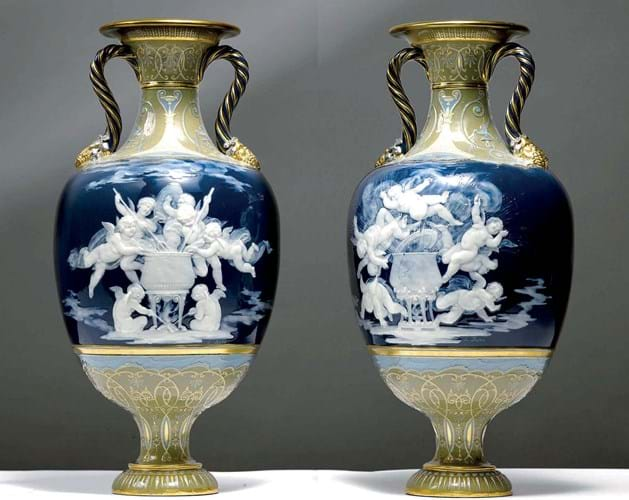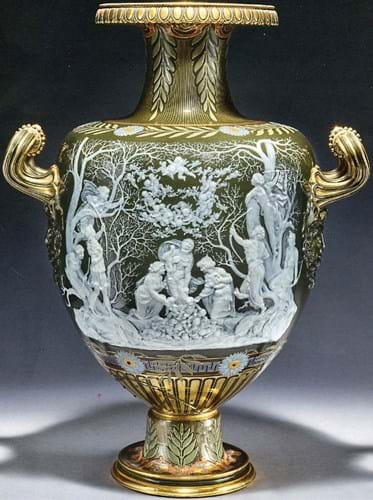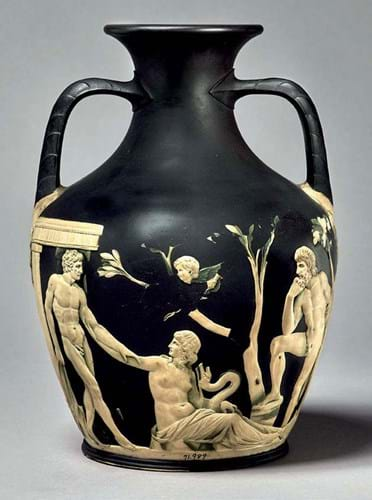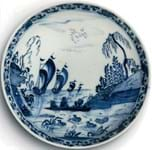
A raft of English and Continental ceramics has gone under the hammer in the US over the past few weeks, much of it courtesy of single-owner collections at Sotheby’s and Stair Galleries.
From Meissen porcelain from the collections of Augustus the Strong, through Wedgwood’s famous jasperwares to Marc Louis Solon’s quirky creations in pâte-sur-pâte featuring battling nymphs and cupids, a rich cornucopia of material was on offer.
A large slice came up for sale at Sotheby’s (25/20/13.9% buyer’s premium) New York rooms as part of its Decorative Arts series. More than 250 lots of Wedgwood and other British ceramics assembled over a 40-year period by Bernard and Lydia Starr offered on October 23 were followed next day by another 199 lots of choice early Meissen porcelain from the collection of Henry H Arnhold, sold to benefit the Arnhold foundation.
After this in Hudson, New York State, Stair Galleries (23% buyer’s premium) had a New York collector’s 270-lot ensemble of classic, mostly English, porcelain and pottery from the 18th and 19th centuries in its October 26-27 sale. The firm followed this on November 1 with the remaining 248 lots from the Starrs’ collection of Wedgwood and other ceramics and decorative objects.

Much of the Starrs’ pâte-sur-pâte was acquired at auction during the 1980s-90s. This single 2ft 1½in (65cm) high vase, which was signed and dated L Solon/84, had a bronze green ground plus two mask terminal handles and was decorated with a scene of maidens shooting arrows at a large group of cherubs to one side, while the other had seven cherubs flying around a maypole. It was purchased at Christie’ New York rooms in 1993 for $23,500 and this time around realised a hammer price of $35,000 (£27,345) at Sotheby’s. Image courtesy of Sotheby’s.
High selling rates
As detailed in our preview in ATG No 2413, Sotheby’s auctions offered two longstanding but very different collections formed by dedicated American collectors with different aims.
The Starrs had spent four decades putting their collection together. Wedgwood was their first interest but they then added 18th century English scent bottles and ‘toys’ and, turning to the 19th century, reticulated artworks produced by George Owen for Royal Worcester and Solon’s pâte-sur-pâte extravaganzas for Mintons. Each field offered choice examples of the genre.
Arnhold was born in Dresden, came to the US just after the war and devoted himself to the Meissen porcelain of his birthplace. Building on the collection he inherited from his mother in the 1970s, he added pieces from the royal collections plus the Asian prototypes that inspired them and figure groups designed by Johann Joachim Kändler, the factory’s most famous modeller. He donated a large slice of his porcelain to the Frick collection in New York as well as making other museum bequests.
While these were longstanding collections, both vendors had carried on adding to their holdings until relatively recently (Arnhold in particular was buying until the final years of his life), so these sales contained some pieces that had been off the market for decades and others that were making a quicker return to the rostrum.
The selling rates for both auctions were high: 244 (95%) of the Starr ceramics got away and 160 (80%) of the Arnhold pieces.
As Christina Prescott-Walker, Sotheby’s specialist, explained: “Everything in both sales at $2000 and below was without reserve so that obviously helped the selling rate.” There was a higher percentage without reserve in the Starr sale, since between Sotheby’s and Stair the entire collection was on offer. The wide range had a decorative appeal to a broader span of bidders. “They weren’t just Wedgwood collectors,” Prescott-Walker added.
Arnhold’s collection was both narrower and more esoteric in scope. “It was a very nice group but it was, after all, what remained after he had given a very big donation to the Frick and other museums,” said Prescott-Walker. Estimates here were also a little stronger, reflecting the higher value of individual pieces. Of those items that failed to sell, a number came from the Asian prototypes that Arnhold had acquired for comparative purposes.
Prescott-Walker said that overall Sotheby’s was very pleased with both sales, especially given the volume of material on offer in New York at the time, and felt that it was good that the market was able to absorb it all.

By far the most expensive piece of Wedgwood in Sotheby’s sale of the Starr collection was this rare early 10¼in (26cm) black and white jasper copy of the famous antique cameo glass Portland vase, one of a number that Wedgwood produced as a first edition. Wedgwood hosted private, ticket-only views of the vase in his showroom in 1790 and this example came with a ticket inscribed Admission to see Mr Wedgwood’s copy of the Portland Vase Greek Street Soho between 12 o’clock and 5. It was last under the hammer in 1999 at Skinner in Boston following de-accession from the Chrysler Museum. Then it realised $4000. This time around it more than quadrupled the estimate to sell for $28,000 (£21,875). Image courtesy of Sotheby’s.
Broad spread of buyers
The buying range was also diverse: “We had a lot of dealer and collector buyers buying direct, a lot of bidding on the internet, a lot of bidding from Europe but completely internationally.”
And although there were a couple of strong buyers in both sales, there were also lots of different individual buyers: “Basically, most of the people that attempted to buy something got something.”
With a few notable exceptions, most of the pieces performed as expected. Being traditional collecting fields, neither Wedgwood nor Meissen are experiencing bullish price hikes at the moment. Whether the results for individual pieces represented an increase on what was paid for them or not largely depended on how long ago they were acquired.

Stair Galleries on November 1 was not a classic piece of 18th century Jasper creamware or porphyry but a modern late-20th century piece designed by the sculptor Glenys Barton (b.1944). She worked as an artist in residence at the factory from 1976-78. Barton produced around 30 designs for Wedgwood and this one, Sky Plateau II, made in a limited edition, is typical of her work in that it is themed around the human figure. The sculpture, set on a 9½in (23cm) diameter cloud-patterned circular base, came with an envelope of letters from Wedgwood pertaining to its order. Offered with a modest estimate of $200-300, it sold for $5000 (£3905).
Stair Galleries’ slice of the Starrs’ collection, for which only one lot had a reserve, was a sell-out with prices ranging from a high of $5000 down to pieces at just $10.
The New York collection offered the week before also had a high strike rate with around 85% of the lots changing hands.
Some particularly high prices were achieved for the small scent bottles from Chelsea and other 18th century factories and for some of the Bow figures. The only area that gave a notably below-par performance was a 38-lot section of early-20th century Chelsea pottery figures by Charles Vyse.
£1 = $1.28














